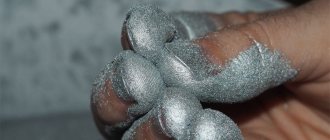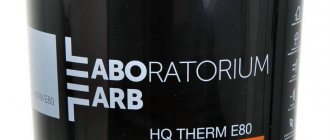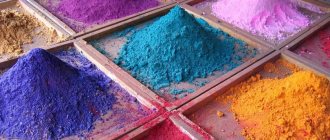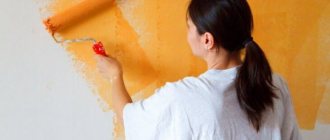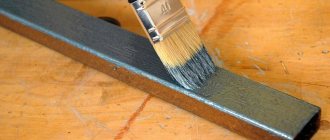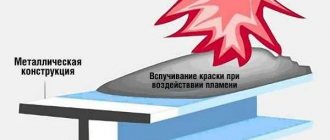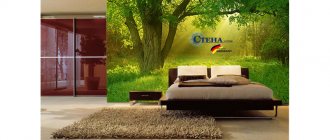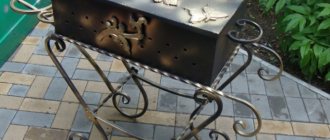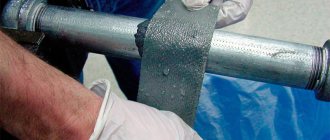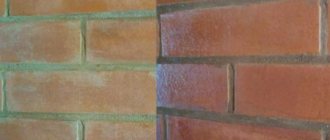Serebryanka is a paint with a metallic color or, simply put, aluminum powder, which is produced by finely grinding aluminum. Grinding is used in two different categories - PAP-1 and PAP-2.
Silver can be used for painting any surfaces outdoors, in conditions of elevated air temperatures (painting stoves, radiators), etc. Therefore, it is excellent for protecting surfaces from the effects of negative environmental factors. It also perfectly protects surfaces from corrosion and lays flat, but for this you need to dilute it correctly.
Compound
The main component of this paint is aluminum powder, which is obtained by crushing this metal. Thanks to this element in the composition, the painted surface receives a metallic color that resembles silver. It is worth noting that the paint itself does not contain silver.
Aluminum dust in the composition of this coating material comes in two types:
- PAP-1;
- PAP-2.
These powders differ in fractions. The first type consists of large particles, and the second of smaller ones. However, the quality of the surface obtained after painting does not depend on the degree of grinding.
If the paint is sold in an already diluted, ready-made form, then it differs in the type of varnish with which it is diluted. If the paint is intended to be used to protect surfaces exposed to high temperatures, then a special heat-resistant varnish is used to prepare it.
Where is silver used?
The areas of application of this paint are quite wide. It is used both in everyday life and in industry. It is often used for painting:
- Radiators, batteries.
- Parts used in production.
- Parts in boiler rooms to protect them from overheating.
- Mostov.
- Port structures, ships.
- Pipe
Properties of aluminum paints
- After the applied silver composition dries, a film is formed on the painted surface, which provides good protection from weathering and moisture;
- The ability of this coating to reflect sunlight protects surfaces from overheating in hot weather;
- Under favorable operating conditions, a surface painted with silver will not lose its properties and original appearance for up to seven years;
- Painted metal surfaces acquire anti-corrosion properties.
Application principles
Coloring principle:
- Prepare the metal surface, degrease it with a solvent.
- Wait until the solvent dries, mix the dye.
- Apply a layer of primer to the prepared surface.
- Wait until the soil dries, apply silver to the metal.
If you need to reliably protect the metal from exposure to water or chemicals, you need to paint it with silver in three layers. When applying new layers, you need to wait until the previous one dries.
Advantages and disadvantages
- Easy to apply. The silver paint is applied in a perfectly even layer, and no smudges form even when painting vertical surfaces;
- Versatility of use. As a rule, metal structures are painted with silver to protect against corrosion, but it can be used to paint almost any surface, for example, wood or concrete;
- Strength. A thin film forms on the treated surface, which does not peel off over time;
- Harmlessness. Aluminum powder does not emit toxic substances, so painting with silver is absolutely safe. Silverfish can only acquire properties harmful to human health if it is diluted with toxic enamel. If non-toxic paints and varnishes are used to prepare the composition, then it is quite possible to paint the internal walls of residential buildings;
- Aesthetic aspect. After the paint dries, the surface on which it is applied acquires a pleasant silver color, but if necessary, you can add color of any desired shade. This is easy to do, since a wide range of different colors are sold on the finishing materials market;
- Long service life. Painted surfaces do not require renewal for a period of 6-7 years, however, if the paint is applied to an object that is in constant contact with water, the service life will be up to three years, without loss of the original appearance or the appearance of cracks.
It is worth noting that, like any paint and varnish material, in addition to the advantages listed above, aluminum paint also has a number of disadvantages.
- First of all, this paint and varnish material should not be applied over other types of paintwork materials. Before painting with silver paint, it is imperative to clean the surface from any remnants of old paint. If you neglect this recommendation, the applied layer may crack, swell and not last even half of the period stated by the manufacturer.
- The second significant drawback is the increased risk of fire and even explosion of silverware in undiluted form. This factor must be taken into account when storing and preparing aluminum powder, therefore it is necessary to observe all precautions and safety measures when working with the material.
Bronze painting
In the old days, many objects were made of bronze. Therefore, painting products in bronze will help to decorate the interior of the house in an old style. There are several technologies for coating metal with bronze. Let's consider the simplest options.
Giving a monochromatic effect
You can perform a single-color coating of metal with bronze as follows:
- First of all, we clean the old surface from dirt and rust. To do this, you need to clean it with sandpaper and then degrease it.
- To increase the adhesion of the dye to the surface, we perform a metal priming process. In addition to adhesion, the primer will help further protect the product from corrosion.
- At the final stage, we begin painting with bronze paint. It is necessary to apply 2-3 layers evenly. But each subsequent layer is applied only after the previous one has completely dried.
Achieving the effect of antique bronze
Decorative antique painting with a bronze effect is suitable for lovers of rare things. To do this, follow these steps:
- Preliminary preparation of the old surface is carried out according to the same rules as in the previous case. Also, do not forget to coat the product with a primer.
- After priming, one layer of bronze paint is applied to the surface. It is desirable that the composition be applied evenly, but for an antique effect it is better to use a brush.
- After drying, the bronze painted surface becomes covered with patina (paint of a darker color). It is applied to the recesses. Experts advise using a translucent patina. This allows you to adjust the shade of the bronze coating.
- The next stage is glazing, that is, processing with a brush that is barely moistened with light paint. The process is carried out on all protruding edges and corners. This aging method allows you to give the product the effect of wear and tear, which usually appears on metal over the years.
- Next, we wait a while, allowing the applied materials to dry completely, and finally we coat the product with transparent varnish.
How to breed silverfish yourself at home
Making silverfish yourself is a fairly simple process that does not require much time. For preparation you need aluminum powder of the required grinding, varnish marked BT-577, a container for diluting and a device for stirring the composition. It is recommended to use a container that will not be used for other purposes in the future.
If you do not intend to use up all the diluted paint, then it is better to use a container for this, which is closed with a lid, so that the remains of the prepared paint and varnish composition can be used the next time it is necessary.
To prepare the paint, the following method is used for diluting the powder, which is added to the container first:
- For PAP-1 fraction powder, this ratio is 2/5 of the total mass of paint that needs to be prepared. The dosage required for kneading must be filled with varnish, and for more effective mixing, a construction mixer is best suited.
- For PAP-2 powder, the dosage is ¼. In addition to varnish, it is possible to prepare silver paint using drying oil, but please note that it must be synthetic based. Preparation is carried out by analogy with varnish.
Preparation and breeding
If silver metal paint was purchased in powder form, it must be prepared before application. Varnish or drying oil is suitable for diluting the dye. When choosing the second option, you need to buy only synthetic fluid.
After purchasing a liquid for diluting silverfish, you need to learn how to properly mix the dye components. Features of paint thinning PAP-1:
- Prepare varnish BT-577. Mix it with silver powder in a ratio of 5 to 2.
- When mixing components, use a mixer set to low speed.
The resulting composition can be applied to radiators and heating pipes. It can withstand heat up to 400°C.
Features of paint dilution based on PAP-2:
- Any varnish is suitable for mixing this type of silver powder.
- Mixing proportions: 3-4 parts varnish, 1 part silver.
- When making a coloring composition, you need to constantly stir the solution.
The resulting paint will be very thick. Before applying it to a metal surface, you need to wait 10-15 minutes.
To apply the finished coloring composition you can use:
- synthetic brushes;
- spray;
- roller
Attention should also be paid to preparing metal surfaces before applying paint. To do this, you need to perform several steps:
- Clean the surface with a metal brush.
- Sweep away the dust with a broom or sponge.
- Remove rust using special chemical compounds.
Preparing the Paint
How to paint with silver
To apply paint, use a roller, paint brush or spray gun. For each of the instruments it is necessary to achieve a certain consistency of the coloring composition. When using a roller or brush, you need to pay attention to the fact that the paint dries quite quickly, so you should avoid long delays when painting individual areas.
Before applying the finished composition, the surface should be cleaned of old paint and varnish, and also leveled if necessary.
How to dilute silver for metal painting
A layer of powder with a binder is applied to the product in any way, then the product must dry completely. Cover the product with liquid bitumen varnish or stain (pigmented glaze (grisal)), so as to fill all the depressions of the relief. Without allowing the varnish/paint to dry, the product must be wiped with a dry, clean cloth on convex surfaces. It is better to use a sponge or a well-absorbing cotton cloth, wipe all surfaces of the relief with light blotting movements, and only remove varnish deposits in the largest recesses. You can always get rid of dried excess using a solvent. The product should not be used until completely dry. If necessary, you can tint the convex parts of the sculpture with bronze powder for the effect of a polished surface.
In the same way, you can achieve the effect of old or “blackened” silver with aluminum powder. For this type of treatment, black artistic oil paint (for example, “gas soot”) diluted in turpentine can be used. The paint is diluted to the consistency of liquid cream. You can use another composition: add a little printing ink to the oil varnish. Today, there are many materials for creating a patina effect: special wax paste, latex glaze coating, stains, translucent paints, etc. For an oxidized bronze effect, use green paint over brown or gray paint. At the end, when the varnish has not yet completely dried, you can carefully spray talcum powder over the surface of the recesses to remove the gloss. What color to use and how much to darken the bronze depends on artistic goals and taste, so all the recommendations given are relative and are of an advisory nature only.
Metal powders can be mixed to achieve different artistic effects.
ATTENTION: getting aluminum or bronze powder into the bronchi and lungs is dangerous to health. Metal powders can cause allergic reactions, choking, cramps
How to wash silver
Washing this paint and varnish composition is a rather complex and labor-intensive process, especially if it is impossible to use a solvent. However, if the solvent with which the material was diluted is still at hand, then its use is the most rational and effective way of laundering.
Experts also recommend using sunflower oil, which must be applied to the stain, then, after waiting a few minutes, wipe it off with a rag.
Another equally effective method is nail polish remover.
As you have seen, if for some reason your choice fell on this particular dye, no special conditions or knowledge are required for its use, it is enough to understand what the composition is in front of you and follow the general recommendations of the manufacturer.
In what form is it produced?
Silverstone can be found on sale in the following forms:
- A powder that must be mixed with a suitable paint and varnish composition before use.
- Ready-made mixtures that need to be stirred before use and, if necessary, diluted with a suitable solvent to the required painting consistency.
Ready-made dyes can be sold:
- In cans or paint buckets.
- In cans. The aerosol form of release is very convenient to use and store, because aerosol paints last longer and no additional painting equipment is required when working with them. Acrylic or other water-based dyes are available in aerosol form.
As sales practice shows, people most often purchase powder formulations for making the necessary mixtures themselves and aerosol cans, often having different colors for decorating walls or painting small surfaces.
Pros and cons of silver
The material has a lot of advantages. It is perfect for interior work, because after drying it becomes non-toxic and 100% harmless. Although there is a smell during operation, so safety precautions must be observed. Other advantages of paint:
- adheres securely to the base, has good adhesion, and lasts a long time;
- can dry quickly and will not require long-term absence of residents from the premises;
- gives the metal anti-corrosion properties and resistance to UV radiation;
- The paint is easy to apply, it does not leave streaks or drips;
- You can paint any material with silver, not just metal;
- the finished paint is stored in an airtight container for up to 6 months, dry powder does not deteriorate much longer;
- The paint can be diluted in different proportions with the solvent, due to which the finished shades will differ;
- The decorative properties of the material are high; it improves the appearance of metal and old wood.
Now some types of silver contain additional additives (for example, liquid glass), which provide enhanced fire-fighting properties. The paint itself is heat-resistant, it can even be applied to stoves, potbelly stoves, radiators, radiators, and pipes. In industry, it is used for painting boiler rooms, bridges, underwater parts of ships, various tanks, and parts. You can paint with silver those products that are used outdoors under the influence of temperature changes, in aggressive conditions.
The disadvantages include the inability to paint with silver when the windows are closed. You will definitely have to buy a respirator and gloves. The powder itself is explosive before application. After drying, the surface will be vulnerable to contamination; it is difficult to wash due to its non-smooth structure. Also, the material will not adhere to oil, alkyd paints, or nitro enamels; they will have to be completely removed.
Wash
During operation, paint may get on surrounding objects. To prevent this, you need to cover the surrounding surfaces with plastic film.
If paint gets on the floor or walls, it can be washed off in several ways:
- Place a few drops of sunflower oil on the painted area. Wait 10-15 minutes. Wipe the surface with any dry cloth.
- Buy nail polish remover without acetone. Apply it to the stain with a brush. Wait 5 minutes. The paint will become wet and cracks will appear. Wipe off the stain with a rag. Wash off any remaining nail polish remover with plenty of water.
When working with silverfish, you need to wear a work uniform, gloves, safety glasses, and a respirator. They will protect the respiratory tract, eyes and body from metal dust.
Silver paint has not lost popularity for several decades. This is due to its unique properties and low price. In order for the painted surface to maintain high strength and an attractive appearance, you need to take into account some nuances when preparing and applying the coloring composition.
Source
Despite the fact that the construction market is replenished with a new range of paint and varnish products every year, the use of silver paint does not lose its popularity and has been used by several generations of craftsmen. What is the secret of such popularity of silverfish? What qualities do such enamels have? Where are they most often used?
Types of silver paints and areas of application
Speaking about the types of silver paint for walls or other surfaces, it is necessary to mention the use of two main types of aluminum powder - PAP1 and PAP2. In this case, the powder is selected based on operating conditions, because the protection properties differ. The composition uses different powder grains.
The first type is used when it is necessary to create a heat-resistant layer, usually used for painting heating devices. When using the bulk of BT577 varnish, the layer will withstand exposure up to +400 degrees.
The second type is used to create a coloring agent without heat-resistant properties, then the addition of synthetic drying oil or other materials can be used as a base. Acrylic, one of the base options for paint. Under production conditions, other substances are added, which increases the protective properties; the exact characteristics of the product are indicated on the packaging.
The following areas can be identified that can be silvered:
- Pipe surface;
- Batteries;
- Steel structures;
- Various boiler room items;
- In shipbuilding;
- Car parts, for example, brake caliper;
- Various decorative elements, fences, gates and other household items.
You can apply paint not only to a metal base. Suitable products for painting leather, other textiles, wood, concrete, etc. After all, painting not only gives a certain protection to the base, but also improves decorativeness.
The powder is selected based on operating conditions, because the protection properties differ.
Silver paint for walls, what happens
Wall covering is usually carried out to give a pearlescent shimmer to the surface, this helps to create beautiful transitions that play in the light. Silver or aluminum powder is added to the coloring agents, which creates the desired metallic effect.
Funds can have a variety of bases. For outdoor work, products are used that can withstand numerous natural loads. The metal is protected from moisture so that the rust formation process does not begin. It is also necessary to make a layer that will withstand ultraviolet radiation, then the color will remain bright and saturated for a long time.
Silver acrylic paint is a popular choice for painting walls and has many positive properties. The compositions stand out by their brightness.
Wall covering is usually carried out to give a pearlescent shimmer to the surface, this helps to create beautiful transitions that play in the light.
Review of popular manufacturers
On the construction market, in any city of Moscow, Perm and others, there is a huge amount of silver paint for metal and other materials. Sometimes beginners get lost in such diversity and cannot make the right choice. In this case, a review of popular manufacturers can help.
High-quality formulations are usually produced by brands that have long been known. You can note the paint from Hammiright, which creates reliable protection against external influences on a metal base.
Creates reliable protection against external influences on a metal base.
The Kudo brand also stands out for its production of various silver platings. There are also spray cans that allow you to quickly coat car parts, and are chosen by car enthusiasts.
You can also highlight other brands that create good products: Lakra, Certa, Serebryanka BT-177 and BT-577 are in demand.
Spray cans that allow you to quickly coat car parts and are chosen by car enthusiasts.
